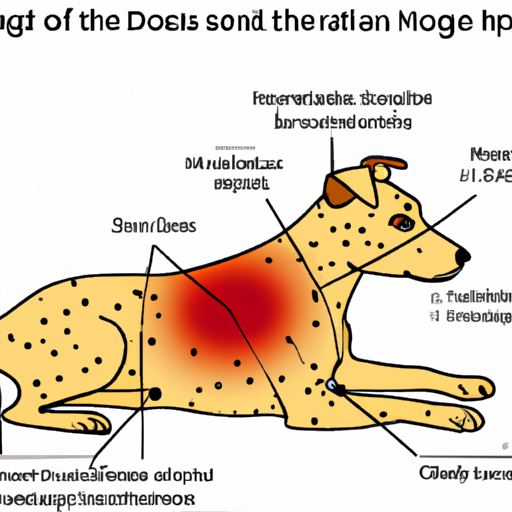Understanding Hot Spots
Hot spots, technically known as acute moist dermatitis, are areas of skin inflammation and bacterial infection. Often, these are circular patches that lose hair, can be swollen, and may exude a foul odor. These can appear anywhere on your dog’s body and can increase rapidly in size.
Why do these occur? The skin becomes moist and warm, attracting bacteria that multiply and create an infection, leading to more itching and scratching, worsening the situation. This vicious cycle can be challenging to break without proper intervention.
Identifying Hot Spots
Hot spots are noticeably red and can be swollen. They are often hot to the touch, hence the name. They can cause significant discomfort to your dog, leading to incessant scratching, licking, or biting at the area.
Here are some signs to watch out for:
- Red, irritated, or raw skin
- Hair loss in the affected area
- Foul smell from the spot
- Obsessive scratching or licking
Common Causes of Hot Spots
Several factors can contribute to the development of hot spots in dogs:
- Allergies: Dogs, like humans, can have allergic reactions to food, insect bites, or environmental factors.
- Poor grooming: A lack of regular grooming can lead to tangled and matted fur, trapping moisture and leading to hot spots.
- Fleas and parasites: These pests can irritate the skin, leading to scratching and hot spot formation.
- Behavioral issues: Obsessive licking or biting due to stress or boredom can initiate a hot spot.
Treating Hot Spots
Hot spots can be painful and irritating for your furry friend, but timely and effective treatment can alleviate the discomfort. Here’s a simple overview of the steps involved in treating hot spots:
- Shave the area: This allows air to reach the infected area and speeds up healing.
- Clean the area: Use a mild antiseptic to clean the area and discourage bacterial growth.
- Apply medication: Your vet may prescribe topical or oral medication to control the infection and inflammation.
- Prevent further damage: Consider an E-collar or other methods to prevent your dog from further irritating the area.
| Steps | Treatment |
|---|---|
| 1 | Shave the area |
| 2 | Clean the area |
| 3 | Apply medication |
| 4 | Prevent further damage |
Preventing Hot Spots
Prevention is always better than cure, and the following measures can help prevent the occurrence of hot spots:
- Regular grooming to prevent matting and tangling of fur
- Frequent checks for fleas and parasites
- Providing a balanced diet to prevent food allergies
- Regular exercise and mental stimulation to prevent stress-related behaviors
FAQs
Q: Can hot spots spread to other dogs?
A: No, hot spots are not contagious and can’t spread to other dogs.
Q: How long does it take for a hot spot to heal?
A: With proper treatment, hot spots can begin to heal in a few days and may fully resolve in a week or two.
Q: Can I treat my dog’s hot spots at home?
A: While minor hot spots can be managed at home with over-the-counter treatments, severe or persistent hot spots should be evaluated by a veterinarian.
Q: Do hot spots leave scars?
A: In most cases, hot spots don’t leave permanent scars but can cause temporary hair loss in the affected area.
Remember, as a caregiver, your dog’s health and well-being are in your hands. Understanding issues like hot spots can help you better care for your furry friend.



